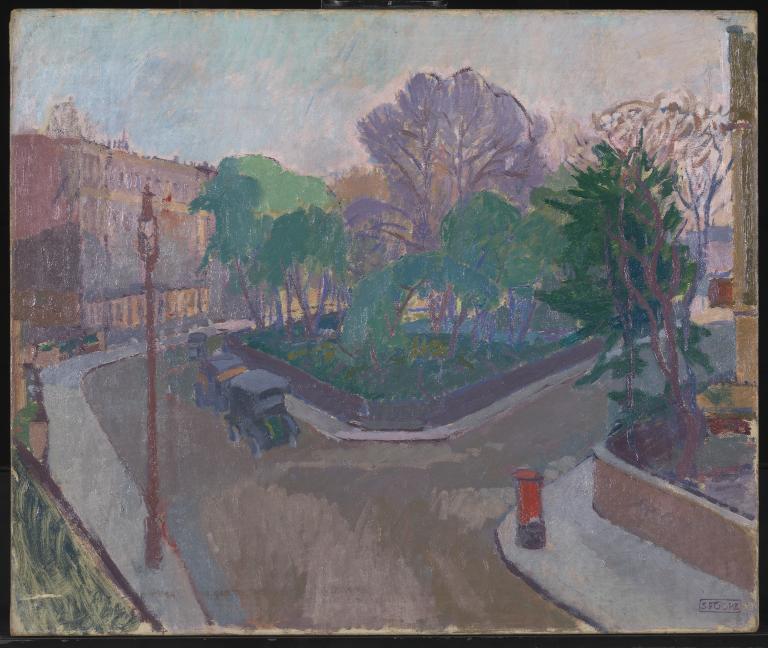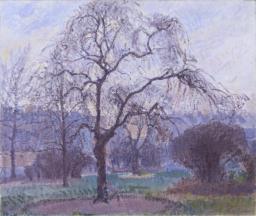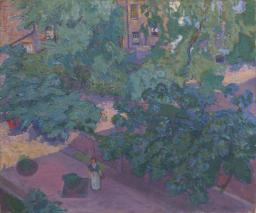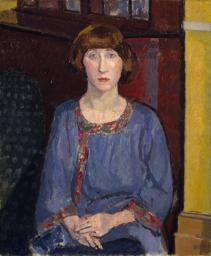Spencer Gore Houghton Place 1912
Spencer Gore,
Houghton Place
1912
A small corner of the balcony is visible in the lower left-hand corner of this painting, which looks towards Ampthill Square from Spencer Gore’s flat in Houghton Place. Streets intersecting at an angle frame the square’s gardens. The high perspective here resonates with Gore’s viewpoints in his music-hall pictures, such as Inez and Taki (Tate N05859).
Spencer Gore 1878–1914
Houghton Place
1912
Oil paint on canvas
510 x 610 mm
Inscribed studio stamp ‘S.F. GORE’ bottom right
Presented by the Contemporary Art Society 1927
N03839
1912
Oil paint on canvas
510 x 610 mm
Inscribed studio stamp ‘S.F. GORE’ bottom right
Presented by the Contemporary Art Society 1927
N03839
Ownership history
Mrs Mary Johanna Gore, the artist’s widow, from whom bought by the Contemporary Art Society 1916 and presented to Tate Gallery 1927.
Exhibition history
1920
Advanced Art, Contemporary Art Society, Derby Art Gallery, April–June 1920 (62).
1923
Paintings and Drawings, Contemporary Art Society, Grosvenor House, June–July 1923 (134).
1935
Silver Jubilee Exhibition of Some of the Works Acquired by the Contemporary Art Society 1910–1935, Tate Gallery, London, July–August 1935 (1).
1944–5
Camden Town Group, (Council for the Encouragement of Music and the Arts tour), Wakefield Museum and Art Gallery, July 1944, Jordans School, Chalfont St Giles, August 1944, Ferens Art Gallery, Hull, August–September 1944, Shipley Art Gallery, Gateshead, September–October 1944, Atkinson Art Gallery, Southport, October–November 1944, Reading Museum and Art Gallery, December 1944, Hanley Public Museum and Art Gallery, Stoke on Trent, January–February 1945 (31).
1968
In and Around the Slade, Laing Art Gallery, Newcastle upon Tyne, February–March 1968 (3).
References
1929
James Bolivar Manson, The Tate Gallery, London 1929, p.141.
1948
John Russell, From Sickert to 1948, London 1948, p.19, reproduced fig.10.
1964
Mary Chamot, Dennis Farr and Martin Butlin, Tate Gallery Catalogues: The Modern British Paintings, Drawings and Sculpture, vol.1, London 1964, p.246.
1979
Wendy Baron, The Camden Town Group, London 1979, pp.192, 374.
1994
Eric Shanes, Impressionist London, New York, London and Paris 1994, p.153, reproduced pl.126.
2000
Wendy Baron, Perfect Moderns: A History of the Camden Town Group, Aldershot and Vermont 2000, p.182.
Technique and condition
Houghton Place is painted in artists’ oil paints on prepared stretched canvas. The cloth is probably linen and has a plain, quite coarse weave. The stretcher is poorly constructed and has been extensively keyed out. The stamp of the artists’ colourman Percy Young is impressed into the top member. Canvas stamps for the same colourman have been found on other works by Gore and by Sickert (Tate T00027, T03561, T01960, N05099, N05090 and T03548). The canvas appears to have been sized and a thick coat of white priming, probably containing lead white, covers the extant canvas and retains the weave texture.
There is no visible evidence of initial drawing in graphic media or paint. The first applications of colour are in thin fluid paint (see also Tate T02260). The masses of the main shapes have been quickly indicated with outlines and brushed-out colour. The earliest state of laying-in remains visible in places, such as the bottom left-hand corner. Areas of the priming are left exposed and thinned colours have retained the brushmarks on drying. Other areas are built up of dense layers that have been reworked. The turquoise blue coloured sky is applied over touch-dry pink paint. The lamp-post has been moved about 10 mm to the left and reduced in height and the road also appears to have been repainted. The work was probably painted over a period of time adjusting the position of key compositional elements and modifying colour in some areas. The definition of compositional forms and the overlaying of different colours represent an early synthesis of two key techniques that Gore developed during this period (see also Tate T01859). It was based on his observation of all colour being relative to its surrounding colour, so that he would re-paint the compositional shapes that he defined to achieve the correct balance:
If you have a red house in a green field against a blue sky, in whatever scale you paint them a tint or the fullest colour you can get, each has some effect on the other. The removal of one would create a new relation between the other two. It may be very subtle or very marked, as in a sunset sky and green fields, if you blot out the sky the colour of the grass is entirely different, and the best thing to trust to for these relations is your eye.1
The painting is varnished; it is not known whether this is original. There is a linear scrape mark that was made accidentally when something made contact with the wet surface of the painting whilst it was drying and before it had been varnished.
Roy Perry
March 2004
Notes
How to cite
Roy Perry, 'Technique and Condition', March 2004, in Robert Upstone, ‘Houghton Place 1912 by Spencer Gore’, catalogue entry, May 2009, in Helena Bonett, Ysanne Holt, Jennifer Mundy (eds.), The Camden Town Group in Context, Tate Research Publication, May 2012, https://wwwEntry
With Walter Sickert as his best man, in January 1912 Gore married Mary Johanna Kerr, known as Mollie. He gave up his bachelor lodgings at 6 Mornington Crescent and moved with Mollie to a flat at 2 Houghton Place, a short distance away, close to the mass of railway lines snaking out of Euston. At Mornington Crescent Gore had painted a great number of pictures showing the view from his window, and in his new accommodation he continued this practice. Houghton Place shows the view from the flat’s first-floor window towards Ampthill Square. The houses in Houghton Place had windows on the first floor which opened out onto a balcony, and this was evidently the level on which the Gores’ flat was located. Access to the balcony allowed him to paint views along the street at a less oblique angle than if he had had to rely on painting from the window.
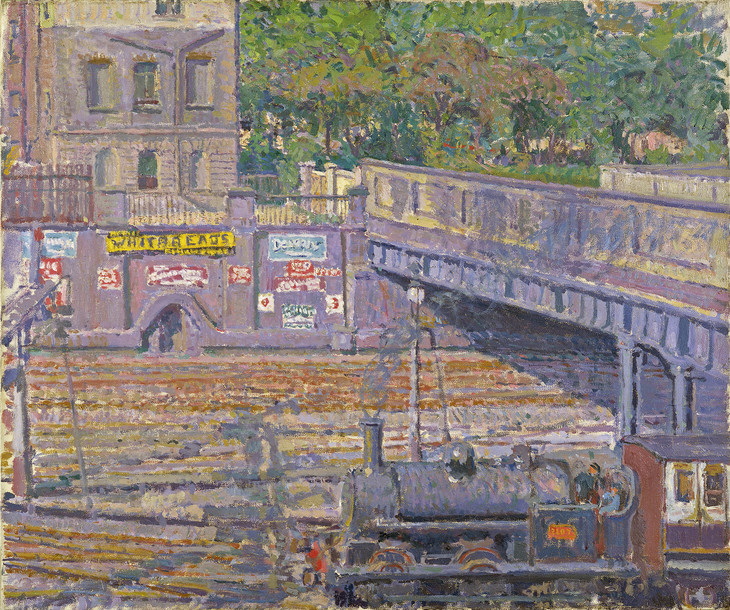
Spencer Gore 1878–1914
Nearing Euston Station 1911
Oil on canvas
498 x 600 mm
King’s College, Cambridge, on loan to the Fitzwilliam Museum
Photo © The Provost and Scholars of King’s College, Cambridge
Fig.1
Spencer Gore
Nearing Euston Station 1911
King’s College, Cambridge, on loan to the Fitzwilliam Museum
Photo © The Provost and Scholars of King’s College, Cambridge
Gore painted a number of pictures from the balcony of 2 Houghton Place. In The Corner of Ampthill Square 1913 (private collection),2 he showed mainly the house on the square’s corner that is visible as a strip up the right-hand side of Houghton Place. This house was also the main focus of View from the Balcony, 2 Houghton Place 1913 (fig.2) which includes in the foreground the cutting diagonal of the balcony railings themselves. There is a resonance in this picture of the juxtaposition of angles and birds-eye viewpoints that are found in Gore’s music-hall pictures. The V-shaped intersection of the balcony in Inez and Taki (Tate N05859, fig.3) seems to find a distant echo in the high viewpoint and street splitting in two directions shown in Houghton Place, and the balcony cutting across the very bottom-left corner of the picture. It is almost as if the tension between the odd angles of Houghton Place and Ampthill Square appealed innately to Gore’s fascination with opposing planes.
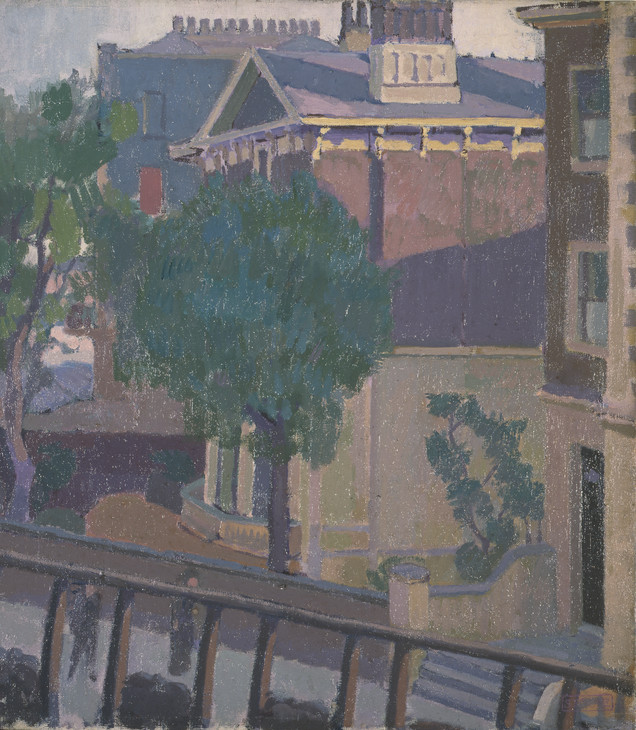
Spencer Gore 1878–1914
View from the Balcony, 2 Houghton Place 1913
Oil on canvas
510 x 458 mm
State Art Collection, Art Gallery of Western Australia. Purchased 1976
Photo © Art Gallery of Western Australia, Perth
Fig.2
Spencer Gore
View from the Balcony, 2 Houghton Place 1913
State Art Collection, Art Gallery of Western Australia. Purchased 1976
Photo © Art Gallery of Western Australia, Perth
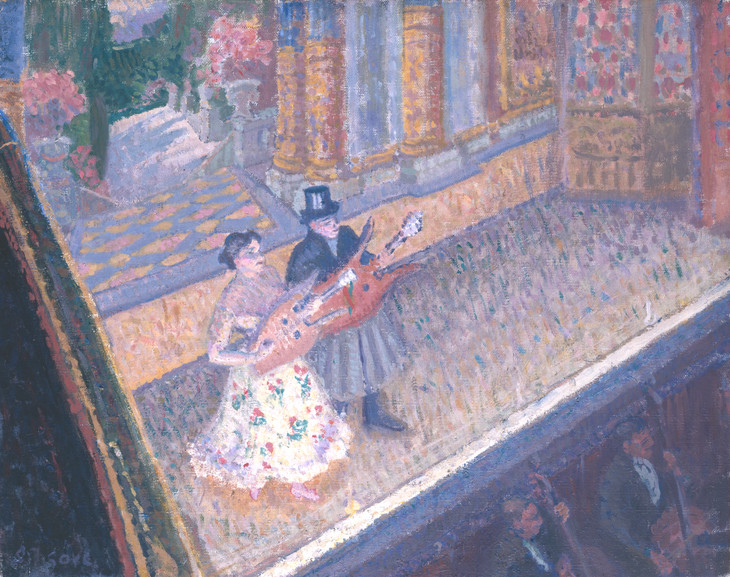
Spencer Gore 1878–1914
Inez and Taki 1910
Oil paint on canvas
support: 406 x 508 mm; frame: 608 x 710 x 52 mm
Tate N05859
Purchased 1948
Fig.3
Spencer Gore
Inez and Taki 1910
Tate N05859
Gore also painted the view looking the other way up the street. In Harrington Square from 2 Houghton Place 1913 (private collection),3 Gore showed a rainy day early in the year before the trees had grown leaves, and emphasised the lighting of a gloomy day and wet streets. This is a contrast to A London Sunset, Harrington Square from 2 Houghton Place 1913 (private collection),4 which, warmly coloured, records a spring or summer sunset.
Unlike The Corner of Ampthill Square and View from the Balcony, 2 Houghton Place, there are no figures in the Tate picture. The streets are deserted, and the only presence is the parked vehicles, including a motor taxi, which by 1912 had become a presence in city life (see Tate N05911). The houses of Houghton Place were substantial five-storey residences built in the kind of brick and stucco Regency style common to Camden Town and Mornington Crescent. When Charles Booth (1840–1916) walked the area with Police Inspector Wait on 28 October 1898 for his survey of London poverty, he recorded in his notebook, ‘East into Harrington Sq and south down Houghton Place into Ampthill Sq: “The whole of this district” said Wait “is on the decline: lodgers are coming in more and more”.’5 In his Maps Descriptive of London Poverty (1898–9), Booth colour-coded Houghton Place as a mixture of red – indicating the second most affluent level in his system of categorisation and described as ‘Middle class. Well-to-do’ – and purple, which was two steps lower and which he described as ‘Mixed. Some comfortable others poor.’ A fact no doubt unknown to the Gores, one of the previous occupants of 2 Houghton Place had been Ellen Ternan, who is now generally accepted to have been Charles Dickens’s mistress. Ampthill Square and Houghton Place were demolished in the spring of 1968 to make way for Camden Council’s three public housing, high-rise tower blocks known as the Ampthill Estate.
The bottom-right corner of the canvas bears the studio stamp that was applied to all the unsigned pictures left in Gore’s studio when he died. In an undated letter, but evidently from a short period after Gore’s death, Harold Gilman wrote to Lucien Pissarro: ‘Mollie Gore wants you and Sickert & me to class and arrange all Gore’s pictures. You are the ones I myself would have wished & I am very pleased.’6 Gilman made a manuscript catalogue of Gore’s works, numbering them in chronological order and designating those he felt were the most important with an ‘a’. The idea of stamping Gore’s pictures was Pissarro’s. Gore’s cousin Nicholas de Grey wrote to Pissarro in June 1914:
Mollie Gore is much pleased at your suggestion of designing a seal for marking Freddy’s unsigned pictures ... What she wants is something about the size of a shilling to contain his whole name S F Gore. Would you turn your brain onto the subject ... Do you propose to cut it in wood or should you propose to have a rubber stamp made? I could get the latter done if that were any convenience to you. I suppose you will send the design to Mollie before it is cut or made. I think she would like that.7
Robert Upstone
May 2009
Notes
Reproduced in Spencer Frederick Gore 1878–1914, exhibition catalogue, Anthony d’Offay Gallery, London 1974 (26).
Notebook B357, pp.26–7, Booth Collection, Archives of British Library of Political and Economic Science, London School of Economics.
Harold Gilman, letter to Lucien Pissarro, undated [1914], Lucien Pissarro Papers, Ashmolean Museum, Oxford.
Related biographies
Related essays
- City Visions: The Urban Scene in Camden Town Group and Ashcan School Painting David Peters Corbett
- A History of Camden Town 1895–1914 David Hayes
Related catalogue entries
How to cite
Robert Upstone, ‘Houghton Place 1912 by Spencer Gore’, catalogue entry, May 2009, in Helena Bonett, Ysanne Holt, Jennifer Mundy (eds.), The Camden Town Group in Context, Tate Research Publication, May 2012, https://www

